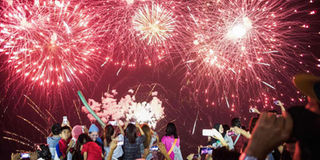How the biggest festival on earth came into being

People watch fireworks display during New Year Celebration in Manila on January 1, 2018. PHOTO | NOEL CELIS| AFP
What you need to know:
Perhaps no carnival involves more millions of people from diverse cultures, political persuasions and religions throughout planet Earth than New Year festivities.
Three of the best-known calendars have their pivot not in recurring natural seasons but religious beliefs supposedly rooted in historical events.
Few events precipitate fever-pitch excitement as welcoming the New Year.
Beginning from the lands of the rising sun in the Far East, including Australia and Japan, and spreading uniformly to the West, millions of people gather in public parks and squares to usher in a new dawn with spectacular fireworks, song and dance in scenes reminiscent of the hit song by Lionel Richie: All Night Long.
Perhaps no carnival involves more millions of people from diverse cultures, political persuasions and religions throughout planet Earth than New Year festivities. Not even Christmas celebrations or the famous Mardi Gras night-long merrymaking in South American towns and cities on Shrove Tuesday before Ash Wednesday can beat the mass parties thrown to welcome New Year.
Various peoples and cultures have come up with their specific calendars based on historical experiences, adaptation to change of seasons and religious beliefs.
Some of the best known are the Jewish or Hebrew, Gregorian, Muslim, Armenian, Assyrian, Chinese, Egyptian, Ethiopian and Japanese.
HISTORICAL EVENTS
While Egyptian and Ethiopian calendars have been influenced by Christianity, there are varieties from traditional African settings that are thoroughly homegrown. An instance is the indigenous calendar of the Igbo people of Nigeria that has 13 months in the year and seven weeks in a month with four market days.
Three of the best-known calendars have their pivot not in recurring natural seasons but religious beliefs supposedly rooted in historical events.
The Hebrew calendar is premised not on astronomy and mathematical calculations alone but two fundamental creeds: The creation of the world by God and the coming of the Messiah.
It can thus be calculated that God created the world in 3761 BC, using the reckoning of the Gregorian calendar. According to the Law of Moses, the Torah, and the authoritative commentary on it, the Mishnah, the Messiah will appear 6,000 years after the Creation. The year we have just transited from, 2017, is reckoned as 5778 in the Hebrew calendar.
MIGRATION
In the 12-month Islamic calendar, the decisive event was the migration (Hijra) of Prophet Mohamed and his followers from Mecca to Medina to form the first Muslim ummah, or community, in AD 622. In this reckoning, AD 2017 in the Gregorian calendar is 1439 in the year of the Hijra, or After Hijra (AH).
But the question remains: Why has the world just transited specifically from 2017 to 2018, exactly at a particular second and with such a bang?
A number of historic events and persons have contributed to this particular confluence. A key player in this long process was a Christian monk named Dionysius Exiguus (AD 470-544). Born and first educated in Scythia Minor in present-day Romania, he moved to Rome, where he engaged in an academic career even as he served as an adviser to the Pope.
Schooled in Greek, Latin and skilled in astronomy and mathematics, he is most famous for introducing a new way of reckoning history through the Anno Domini (AD) era notation. He explicitly states in one of his many writings that “the present year is 525 since the incarnation of our Lord”.
MISCALCULATION
It was, however, discovered later that he had made a slight error in transposing from the old system that reckoned history from the founding of the city of Rome,Ab Urbis Condita, (AUC) to his new AD system. An audit by later mathematicians revealed that he had made a miscalculation that made Jesus get born between 6 and 4 BC!
The famous English monk Venerable Bede popularised Dionysius’s innovation through his widely read Ecclesiastical History of the English People, published in the 8th Century AD.
Another decisive factor was Pope Gregory XIII, who affirmed the innovation of Dionysius. The pontiff also accepted the recommendations of a commission to reform the Julian calendar by making several adjustments with regard to leap years. This gave rise to the Gregorian calendar, which he promulgated in 1582.
The Gregorian calendar, born in the cradle of religion, is the most widely used for civil, trade and other pragmatic purposes.
A happy and prosperous 2018!
Father Lawrence Njoroge, a priest at the Archdiocese of Nairobi, is a professor of development studies and ethics at JKUAT, where he is the Catholic Chaplain. [email protected].





